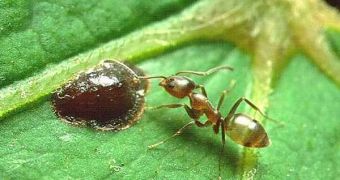Talk about world domination! We, humans, live under the impression that we are the most widespread and numerous species on the planet, when the reality couldn't be much further from this “truth,” as evidenced recently by a groundbreaking discovery. It would appear that the three mega colonies of Argentine ants, living in Europe, the United States and Japan, are in fact a single, enormous one, comprising billions of individuals, which all live in harmony if placed together in any combination.
For a long time, naturalists have had a hard time believing that the United States colony, for instance, which stretches for about 900 kilometers along the coast of California and is known as the “California large,” was not made up of any subdivision. It's a well-known fact that Argentine ants are extremely territorial, but, even when putting together ants from the different ends of the colony, they did not attack each other, and recognized themselves as being part of the same family.
The same discovery applied to the European and Japanese colonies as well. On the Old Continent, for example, the Argentine ants (Linepithema humile) live in a colony about 600 kilometers wide on the coast of the Mediterranean Sea, while, in Japan, the third colony occupies the entire West coast. Up until recently, the three colonies were recognized as being of the same species, but they were thought to be distinct among themselves, a fact that would have been confirmed if, when placed together, ants from the three areas of the world would have attacked each other.
However, that didn't happen, and the researchers started suspecting the amazing truth – that, essentially, all Argentine ants living in the world at the moment, regardless of their mega-colonies, were actually part of the same family, and would live together peacefully whenever they came in contact with each other. The find was further proven when chemists analyzing the cuticles on the insects discovered remarkably similar hydrocarbon compositions, which hinted at a common origin, but also at the fact that the three thought-distinct families were, in fact, a single, global one. That is to say, all Argentine ants living on Earth, in spite of being thousands of miles apart, are actually part of the same colony.
Moreover, the researchers note, it was humans who allowed for this massive population to be born in the first place, by transporting the ants from their original South American habitat to all areas of the world. Now, whenever people come across them, they are considered to be pests, as they attack crops and even farm animals, and overwhelm them with their sheer numbers. Individual colonies number in the millions or tens of millions, and they can easily make their way through pretty much everything, the BBC News reports.

 14 DAY TRIAL //
14 DAY TRIAL //